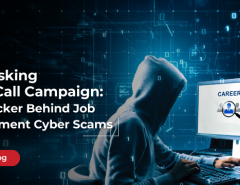Cyber-attacks on endpoints and networks are continuously growing, and organizations need to get their defense up and running. That said, the technological advancements are working well against cyber criminals and the breaches are now harder to create. This is why cyber criminals are currently concentrating on a new form of vulnerability with individuals being their focal points.
Understanding Phishing Emails
Sometimes an employee opens up an email unintentionally which links to a phishing website. Be it an unsuspecting word document with hidden ransomware script or something that compromises the security of the entire workplace; phishing emails are commonly clicked on. As per reports, almost 30 percent of the entire workforce regularly clicks on a phishing email and associated links thereby making it a highly complex issue to deal with. It is thus, essential for organizations to spread awareness about phishing emails amongst their people. While conducting training and reinforcing security policies and procedures is a good start point for educating employees about phishing, simulation is an excellent way to keep them alert.
Phishing Simulation: Getting Started
Any simulation test needs to start with introductory training where employees are educated about email safety and phishing implications. Every organization needs to setup an anti-phishing email account where employees can readily share their experiences, suspicions and other requirements concerning cyber threats.
However, there are many steps to a phishing stimulation test which inadvertently start off with proper planning. Organizations need to be careful regarding the modus operandi of these phishing simulation tests which are explained below in detail:
- Conducting frequent phishing tests via emails isn’t advisable as then people start expecting and even the cyber criminals are readily alerted.
- That said, infrequent simulation tests are equally ineffective as companies will then have very few reports and statistics to rely upon.
- Phishing simulation requires an organization to think like an attacker— sending out shady emails now and then.
- The mentioned technique is more like a test which checks whether the employees are still clicking on suspicious links.
- Phishing emails shouldn’t be forwarded to the entire company as it sparks suspicion. Instead, the process should be organic and must target a group of select employees, typically on a monthly basis.
- Most phishing simulation tests are usually planned out over a period of 12 months. However, there can be certain ad-hoc campaigns which are situational.
When it comes to drafting phishing emails based on the subject lines, companies can use a host of options for getting the perfect response from their employees. Be it the functional ‘We Won’t Pay This’ mail or something that says ‘Get Something Free’; there are diverse options which can entice viewers to click malicious links.
Getting Hold of Reports and Training Employees Further
Any good phishing simulation test includes tools that send out timely reports. These tools help companies track open rates, CTRs and even the number of employees who have reported receiving phishing emails.
When it comes to detailing company expectations, the click through rates are presumably lower after a successful, company-wide phishing stimulation test. Trend reporting rates are usually on the higher side and this process eventually reveals the weakest link in the organization. Conducting simulation tests like these allow companies to adjust and modify the training principles based on the existing results.
There are instances when a particular person in the organization clicks on these links frequently. According to the phishing simulation scheme, such individuals must be personally trained by the IT/security professionals.
Following Up
Every phishing simulation campaign needs to be followed up by relevant emails where the IT department informs the concerned employees about the reality of phishing emails and what is expected of them in return.
Using the Right Tools
Phishing simulation software or tool is necessary for safeguarding an organization against cyber criminals. Companies need to select tools that send out timely reports in the form of detailed statistics. In addition to that, certain firms also make use of digital certificates which are meant for authenticating and validating users. These certificates are added to the emails thereby vindicating their legitimacy.
Needless to say, phishing simulation tests can surely keep the employees alert by putting minimal stress on the confidentiality of the involved organization.
As an IT security partner for your business, Seqrite provides comprehensive endpoint security from advanced cyber threats. To know more, visit our website.




